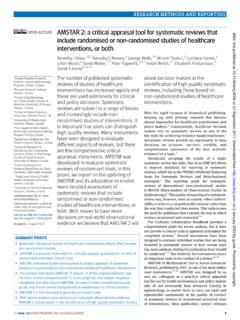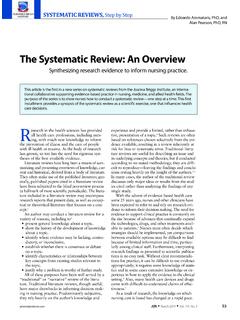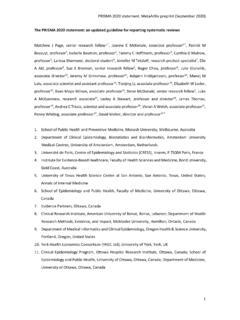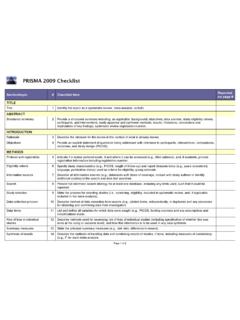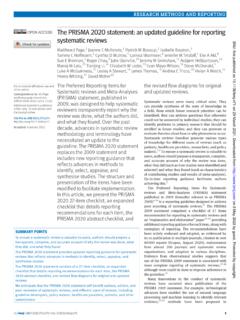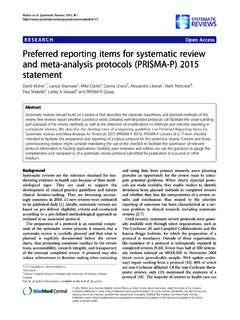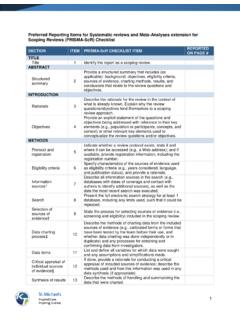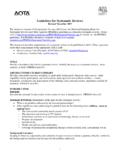Transcription of Systematic and Non-Systematic Literature Review ...
1 Evidera, we routinely have conversations with external colleagues who would like our help in gathering publicly available information to answer research questions, inform business decisions, support submissions to external authorities, or provide inputs into other research efforts such as economic analyses. The scientific Literature is a rich source of information that can guide healthcare research and decision making, and a Literature Review is often a cost-effective and time -efficient approach to gather our experience, different people may have quite different types of studies in mind when they use terms such as Systematic Literature Review .
2 At a minimum, this range of understanding can result in confusion and unclear expectations and, in some cases, it could even impact the success of the Literature Review as a stand-alone project or the success of associated downstream activities such as qualitative or quantitative research or external accompanying table outlines some common types of Literature and informational reviews, their typical methodology and objectives, and how they might be used to inform other s in a Name? Systematic and Non-Systematic Literature Reviews, and Why the Distinction MattersRachel Huelin Director and Research Scientist, Meta ResearchIke Iheanacho, MBBS Director and Research Scientist, Meta ResearchKrista Payne, MEd Executive Director, Evidence Strategy SolutionsKaren Sandman, PhD Practice Lead, Payer CommunicationsType of ReviewDefinitionMethodologies EmployedObjectives and Typical ApplicationsSystematic Literature Review (SLR)
3 A scientific study designed to address a specific research question by comprehensively collecting all the information available on a topic that is defined at the outset by absolute inclusion and exclusion criteria. Considered the gold standard for evidence appropriate, this gold-standard approach may be adapted to produce a more manageable scope while retaining elements that ensure rigor and minimize bias in the identification of relevant Literature ( , use of a protocol, Systematic search, and screening).
4 Such an approach is sometimes called a structured established guidelines set down by authorities such as the Institute of Medicine and the preferred reporting Items for Systematic Reviews and Meta-Analyses (PRISMA) involves searching multiple, predefined electronic databases and grey Literature criteria define topic areas as well as characteristics such as publication dates, the languages in which articles are published, and whether articles describe only human search and screening protocol is reported in the methods section of the report, along with a PRISMA diagram.
5 A flowchart showing the number of and reasons for articles being identified and excluded at each step of the the optimal type of Literature Review for publication (particularly in higher tier medical journals) and conference for many payer submissions and other types of formal documentation. Findings can be used to conduct a classical meta-analysis or network meta-analysis (indirect/mixed treatment comparison); may also be used to provide inputs for economic be qualitative, , to assess burden of illness; epidemiology; clinical, economic, and humanistic outcomes; or treatment patterns.
6 This information can be used to guide evidence generation strategies and clinical development EVIDENCE FORUM May 2015 Type of ReviewDefinitionMethodologies EmployedObjectives and Typical ApplicationsTargeted Literature reviewAlso called a focused Literature Review A Non-Systematic Literature Review that is meant to be an informative, rather than all-encompassing, Review of the Literature on a takes an in-depth but not Systematic approach to a specific research based on a knowledgeable selection of current, high-quality articles on the topic of or may not follow a predefined strategy and support evidence-based decision making within a product to identify trends and better understand the current state of a the preferred approach for populating disease and treatment background sections of a dossier or for identifying model be published.
7 But generally appears in lower tier journals than Systematic Literature reviewA comprehensive Review of health technology assessments (HTAs) regarding a medical intervention, product, or therapeutic , a defined list of HTA sources and sites are searched using a fairly broad set of search terms relating to the subject resulting HTA reports are screened for past payer decisions and feedback on an area of evidence generation and clinical development potential payer concerns and proactively develop evidence-based Review or disease area strategy reportA rapid Review of key topics of interest relating to a therapeutic area.
8 Including but not limited to burden, unmet need, competitive landscape, payer perspectives, regulatory considerations, and data evidence from Literature , pricing and reimbursement sources, HTAs, and other public sources and, in some cases, proprietary sources such as payer and provider research, and advisory be used to inform decision making on in-licensing opportunities or new development background evidence for a preliminary framework value proposition, value demonstration plan, and/or payer research analysisAn analysis of topic areas in which evidence is sparse or nonexistent, often conducted as part of a Literature Review and/or evidence generation area experts typically analyze outputs of a targeted or Systematic Literature Review and identify gaps, and then conduct follow-up searching to confirm the lack of potential concerns that may arise from an evidence generation type of Review would best suit your needs?
9 When considering what type of Review would best meet your research and business objectives, ask yourself and your colleagues: What is the evidence need, and which specific research questions do we want to answer? How much time and resources can we commit tothis effort? How quickly do we need the research findings tobe available? Who are the internal and/or external audiences forthis Review , and do they have specific expectations or stipulations about how it will be conducted? Are there established guidelines governing how thistype of Review should be conducted?
10 Do we intend to publish our findings? Would this Review be useful to other work streamswithin our organization? If so, do their requirementsdiffer from ours?REFERENCES 1 Moher D, Shamseer L, Clarke M, Ghersi D, Liberati A, Petticrew M, Shekelle P, Steward LA, and PRISMA-P Group. preferred reporting Items for Systematic Review and Meta-analysis Protocols (PRISMA-P) 2015 Statement. Syst Rev. 2015 Jan 1; 4:1. For more information, please contact or

